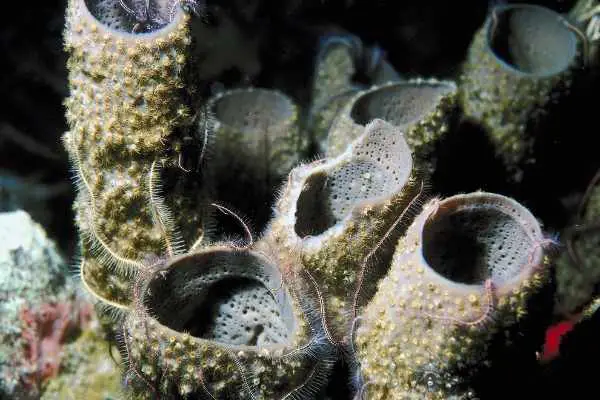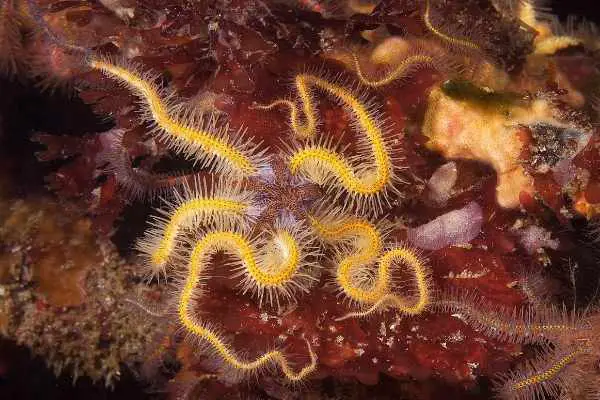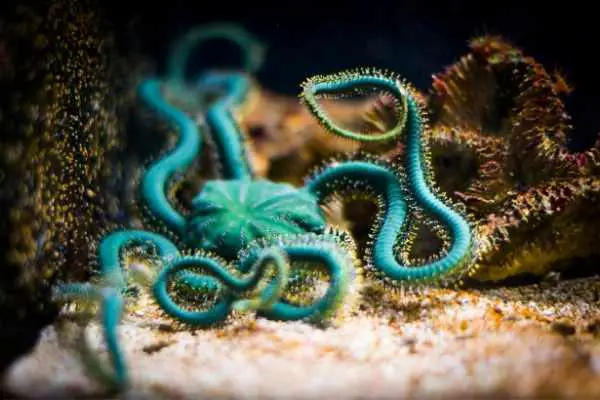The brittle starfish (Ophiuroidea) or brittle star group either enchant or repulse you. They follow the expected pattern of five “limbs,” but they lack that adorable star design. Instead, you get long, snaking legs that move in every direction – sometimes independently. But these echinoderms bring a particular fascination with them. And if you’re one of the people that find them positively fascinating? You’ll want to learn everything you can.
Table of Contents: Brittle Starfish Care
Brittle starfish range from tiny to monstrous and bland to colorful. And their personalities are equally varied. As such, you’ll probably want to stick through the entire article to gain as much information as possible. But if you’d rather look for the answer to a specific question, these links will do the trick.
- Quick Facts
- Description of the Brittle Starfish
- Brittle Starfish Lifespan
- Creating the Ideal Brittle Star World
- Brittle Starfish Diet
- Brittle Starfish Behavior and Tank Mates
- Breeding the Brittle Starfish
- Pros and Cons
- For More Information
Quick Facts
- Common Names: Brittle starfish, Brittle star, Fancy brittle star, Tiger striped serpent sea star, Banded brittle starfish, Banded serpent star, Black-banded serpent star, Brittle sea star, Fancy serpent sea star, Mosaic brittle star, Painted serpent starfish, Superb brittle star, Tiger-striped sea star, Zebra brittle starfish, Green brittle star, Red serpent starfish
- Scientific Names: Ophiuroidea (Over 2,000 species)
- Size: Up to 14 inches (35.6cm) or more
- Minimum Tank Size: 50 Gallons (189L)
- Reef Safe? Yes
- Care or Experience Level: Moderate
- Preferred Diet: Omnivore
- Original Part of the World: Global

Description of the Brittle Starfish
Brittle starfish (occasionally also referred to as serpent starfish, though they’re a separate group) resemble a collection of long, snaky arms. So it’s no wonder that Ophiuroidea means “snake-like.” It describes those flexible appendages AND the way they move.
While brittle stars have tube feet, they don’t use them to get around the way the average sea star will. Instead, they employ those spiky arms to “grab” onto the substrate, rocks, coral, or sponges around them. Then they use the rest of their arms to pull them forward. And if there’s nothing handy to grip? You can see these invertebrates putting those arms to work in a “swimming” motion to propel them through the water. All of that coordination earns them the title of fastest echinoderm in the ocean.
And as this YouTube video demonstrates? It makes them VERY accomplished dancers:
In the middle of a brittle starfish, you’ll find the central disk. It’s not the most impressive feature, coming in at a few inches/centimeters at best. It holds their mouth with its five toothed plates. (Think Kraken) Unlike other echinoderms, though, the jaws remain fixed. And they can’t evert their stomach through the mouth to aid with digestion. So they use their tube feet to pass food particles up to the mouth. And the tube feet? They pop out of holes between the ossicles on the arms.
The ossicles are the individual plates of calcium carbonate that form the arms of the brittle starfish. They connect the same way our ball-and-socket joints do. As the brittle star grows, it continues to add ossicles off the central disk. This comes in handy as those arms serve another crucial function: defense. When confronted by a predator, the echinoderm can break off an arm and leave it behind. Connective tissue within the ossicles changes from rigid to soft, causing the arm to flop around and distract the predator while the brittle starfish slips away. The limb can then regrow over time. (It’s where the “brittle” part of brittle starfish came from)
And the awe doesn’t stop there. The red ophiocoma (Ophiocoma wendtii) may even possess the ability to use chromatophores along its body to turn itself into a rudimentary EYE! During the day, the brittle star is a maroon color, and it manages to scurry into shadows without a problem. But at night? It turns beige and loses the ability to differentiate shades. Scientists believe that maroon color functions as a kind of “sun block” that allows the brittle starfish to determine dark from light.
With over 2,000 species of brittle stars, you find every possible size and color. The tiniest members of the group usually hide out in sponges, with only those snaking arms visible. Some even form symbiotic relationships with other invertebrates. For instance, Ophiosphaera insignis lives alongside the mouth of a sea urchin. It’s safe from predation and picks up all of the leftovers dropped by the urchin. In a similar behavior, the feather-hitching brittle star (Ophiomaza cacaotica) stays close to the mouth of feather stars.
Brittle Starfish Lifespan
As you might guess, with TWO THOUSAND (or more) species of brittle starfish out there, they cover plenty of territories. And you’re right. These echinoderms span the globe. You can spot those snaky arms in reefs everywhere you look. Divers even documented 73 species in the Arctic!
Of course, you don’t need that kind of speed (to say nothing of that “escape plan”) unless you’re on the menu of plenty of predators. As such, these spiky invertebrates spend most of their lives in hiding.
Adding ossicles to those arms, brittle stars reach their maximum size around 4-5 years. And they survive for a solid eight years – if they’re lucky. In captivity, though, they usually only make it to around 3-5 years.

Creating the Ideal Brittle Star World
Brittle starfish cover the globe. Not literally, of course, but you have the potential to spot them from the Caribbean, around Fiji, down to Australia, and throughout the African coast. If there’s a reef or seagrass bed? Odds are a snaky arm might show up under a rock or buried in the sand. All of those species spread out from shallows down to the abyssal depths of 11,000 feet (3350m)!
As a group, Ophiuroidea work to reshape sediment. As they take their strolls, those long, snaking arms move sand and coral rubble around. And their opportunistic diet helps keep ecosystems clean. It’s why you tend to find them hanging out with the sessile invertebrates of the reef, such as sponges and corals.
And that’s all you need to set up a saltwater aquarium a brittle starfish will happily call home. A comfortable system of live rock, complete with handy crevices and overhangs will do the trick. These echinoderms are nocturnal, and they need somewhere safe to retreat to during the daylight hours. Depending on the size of your brittle star, you may see them seeking protection with your sponges or corals. And when night falls? They’ll venture out to explore.
Most of the brittle starfish group are scavengers, so using live sand will keep them active and happily supplied with snacking material. Don’t go overboard with vast stretches of “open ground,” though. These invertebrates need a chance to reach a safe zone as quickly as possible (good thing they’re more mobile than the average sea star!).
Some aquarists end up with brittle starfish entirely by accident. The tiniest species in the group frequently hitchhike on live rock. You’ll notice the fuzzy arms popping up on your corals after you add the rocks to your tank. They’re a unique find – and not one you’ll encounter for sale in the fish store!
Brittle Starfish Tank Size
Obviously, there’s a dramatic range in size for brittle starfish. Some species rarely grow more than 0.5 inch (2cm) – and that’s including those sweeping arms. Others can exceed 20 inches (50.8cm) in the wild on a healthy, predatory diet. And you’ll find everything in between.
So how do you decide the room you’ll need to keep these roaming echinoderms? (Excluding those minute hitchhikers that make themselves at home without permission) On average, a 20-gallon (76L) tank will work for most species. But if you want to provide the most hiding places and exploration possibilities, spring for 50 gallons (189L).
You need to ensure your saltwater aquarium has completely cycled. Brittle starfish have low tolerances to nitrates, in particular. But they also struggle when water parameters start to fluctuate. If you’re still working to balance your tank, hold off on adding these fragile invertebrates. You’ll also need to perform partial water changes regularly to stay on top of those nitrates. If you don’t, you run the risk of losing your brittle star.

Are Brittle Starfish Reef-Safe?
Some live rock hitchhikers wreak havoc in reef tanks. Others bring benefits. And others end up somewhere in the middle. Brittle starfish can fall into all three classes, depending on the species. (Okay, so you purchased one, rather than waiting for it to make its way into the aquarium. The analogy still works)
Overall, these little starfish won’t bother your corals. They clean up detritus around the tank without damaging polyps in the process. And that impressive speed keeps them safe during their nocturnal foraging trips when corals might deploy sweeper tentacles.
However, there ARE exceptions to the rule. You’ll find carnivorous species that turn on feather dusters when they’re hungry. If you fail to provide enough sustenance, your brittle starfish might start tearing the poor tube worms out of their shells to feed on them. And the red serpent starfish (Ophioderma squamosissimus) will eat ANYTHING it can find, including other invertebrates. That means your crustaceans are ALL on the menu.
Brittle Starfish Diet
Brittle starfish are opportunistic carnivores. The tube feet between the ossicles serve as handy collection devices for food particles. Zooplankton and detritus end up trapped in mucus on the ossicle spines or even the surface of the starfish itself. With one swipe, the feet collect the meal and pass it down to the mouth in the central disk. And, of course, those flexible arms work well to grab onto prey.
Brittle stars go to work in a reef tank, sweeping up leftovers as soon as the lights go down. Pulling themselves around with their arms, they scavenge over the bottom and rocks, picking up detritus as a member of the clean-up crew.
But you still need to provide supplemental feeding. Brittle starfish that don’t receive enough nutrition can develop nasty habits. Some turn on tank mates (such as feather dusters). Others? They start to devour their OWN ARMS! (Talk about stress eating) If that mouth doesn’t have a “meaty” look to it, your brittle star is getting close to the edge, and you need to step up.
Meaty foods work best. As long as you chop everything into fine pieces (consider the mouth size of your particular brittle starfish), you can use any of the following:
- Clam
- Mussel
- Shrimp
- Silversides
Odds are, as soon as that delicious tidbit hits the water, your brittle star will come out to investigate. The tube feet contain the same sensors you see in sea stars. They’ll catch the “scent” and swoop over to devour the meal. (Provided it’s safe to do so, anyway)

Brittle Starfish Behavior and Tank Mates
Brittle starfish spend the day hiding out under rocks, tucked away in sponges, or buried under the surface of the sand. When night falls, they emerge to hunt and scavenge. The nocturnal habits protect them from the reef fish that don’t mind chomping down on those spiny arms. Because while they’re fast (for an echinoderm), they lack the speed necessary to escape larger predators.
And that’s something you need to keep in mind when you bring one into your saltwater aquarium. Plenty of animals find brittle stars tasty snacks. And it isn’t fair to put your invertebrate on the menu if you already have these inhabitants:
- Arrow crabs
- Boxfish
- Harlequin shrimp
- Parrotfish
- Pufferfish
- Triggerfish
Luckily, you’ll find fish out there that don’t mind sharing a tank with these spindly starfish. These groups are happy to coexist and ignore the brittle starfish as it crawls around the substrate, sweeping up leftovers:
- Butterflyfish
- Clownfish
- Damselfish
- Dwarf angelfish
- Tangs
Most importantly, brittle starfish work in concert with other members of the clean-up crew. And the shrimp species will leave your brittle stars in peace. It allows you to build a more vibrant and varied aquarium.
However, everything comes crashing down when you decide you can’t resist green brittle stars (Ophiarachna incrassata). True, they’re some of the most colorful of the group. But they’re not known as green monsters for nothing! Green brittle stars are predators, and they’ll hunt down and eat the fish in your tank. They emerge during the crepuscular period (dusk and dawn) to start searching for a meal. And they can easily grow up to 14 inches (35.6cm), putting plenty of your fish and invertebrates at risk.

Breeding Brittle Starfish
In theory, breeding brittle starfish isn’t tricky. However, no one’s entirely confident whether they’ve achieved success in the home aquarium. And that’s because it’s impossible to decipher males from females based on appearance. And certain species ARE hermaphrodites. Oh, and the dwarf brittle star (Amphipholis squamata) can self-fertilize (just to keep things interesting).
Then there are all of the possible methods for reproduction (why have one when you have 2,000 species?). It leads to plenty of confusion on exactly HOW those other brittle stars end up in the tank.
In those species with separate sexes, most brittle starfish achieve sexual maturity around 1.5-2 years. (That’s late in life for an invertebrate) To spawn, the brittle stars climb to high points on the reef, go into a “push-up” posture, and extend their central disk. The gametes are stored in a pouch within the disk, and they release them into the water. The fertilized eggs hatch and the larvae undergo two metamorphoses. The first stage looks NOTHING like a brittle star. It’s a bilaterally symmetrical form that swims about in the plankton. The second stage resembles a brittle star and settles onto the substrate.
Of course, with that system, you have variety too. Some brittle starfish brood their eggs. Others incubate the young within the central disk. Pouches provide nourishment while the larvae develop. The juveniles then release when they’re ready to settle.
Outside of sexual reproduction, you have the possibility of fission. If a body part splits away, an entire brittle starfish can regenerate from that ONE piece. It’s a form of asexual reproduction, resulting in an identical clone.
Pros and Cons
Brittle starfish are fascinating – provided that snaking movement doesn’t weird you out. Once you get past THAT part of the equation, you still need to consider some pros and cons of adding this echinoderm to your reef tank.
Pros
- Brittle starfish can drop an arm as an escape trick with predators. The arm will regrow over several months.
- Most brittle stars are reef safe, ignoring corals and other crustaceans while cleaning up leftovers and detritus around the tank.
- Brittle starfish don’t require a specialized diet. They’ll accept chopped portions of any raw, meaty seafood.
Cons
- Brittle starfish don’t ship well. As they’re prone to parasites and nematodes, you should quarantine any new additions and monitor for signs of lesions or white slime on the body.
- Brittle stars are sensitive to the nitrate levels in the water or ANY fluctuations in the water conditions.
- As they are invertebrates, you CANNOT introduce any copper medications to the tank, or you’ll kill your brittle starfish.
For More Information
Sure, brittle starfish put people in mind of snakes, spiders, and aliens. They look weird, they move funny, and they’re not adorable (like “normal” starfish). But they’re wildly interesting echinoderms. And once you dive into more information about them? You’ll see why.
This YouTube video takes a peek at a brittle starfish hiding out for the day:
Want to know about some of the best brittle starfish tank mates?
Want to learn more about other members of the clean-up crew? (Don’t worry – they’re safe to keep with brittle stars)
Conclusions
Yes, brittle starfish look strange. And when you see one booking it across the substrate, you have to take a moment and pause. Then you start to realize how incredibly cool these little (or not so little – it’s species-dependent) invertebrates are. For not possessing a complicated brain, they’re amazingly successful throughout the ocean. And in your tank? They’ll add the perfect touch of color.
Just research the species you decide to bring home. You don’t want to wake up and find out your green monster or red serpent devoured everyone overnight.
References
- Allen, G.R. and Steene, R. 2002. Indo-Pacific Coral Reef Field Guide.
- Frazer, J. 2020. “The Brittle Star That Sees With Its Body.” Scientific American.
- Gosliner, T.M., Behrens, D.W., and Williams, G.C. 1996. Coral Reef Animals of the Indo-Pacific: Animal Life from Africa to Hawaii Exclusive of the Vertebrates.
- Hendler, G., Miller, J.E., Pawson, D.L., and Porter, M.K. 1995. Sea Stars, Sea Urchins, and Allies: Echinoderms of Florida and the Caribbean.
- Pechenik, J.A. 2005. Biology of the Invertebrates.


Leave a Reply